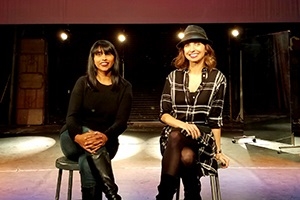Mixed: Documentary to Explore Interracial FamiliesPosted in Articles, Communications/Media Studies, Family/Parenting, United States on 2017-01-08 00:05Z by Steven |
Mixed: Documentary to Explore Interracial Families
American University
Washington, D.C.
2016-12-15
Gregg Sangillo, Online Writer
 School of Communication professors Leena Jayaswal (l) and Caty Borum Chattoo (r) are making a film about interracial families in the United States. |
It took a while for documentary filmmakers Leena Jayaswal and Caty Borum Chattoo to realize that they were part of their own story. They’re both in interracial marriages with biracial children, and that’s the subject of their upcoming film, Mixed.
“Everybody kept telling us this film is about the two of you. And we said, ‘No, it’s not.’ But then somebody would say, ‘Why are you making this film?’” Jayaswal recalls.
The documentary is a travelogue—talking with people in Atlanta, Cleveland, Houston, and Los Angeles, among other places—but Jayaswal and Borum Chattoo are inextricably linked to the subject matter at hand.
“It’s a journey film about the two of us finding mixed-race stories across America,” says Jayaswal, an associate professor at American University’s School of Communication.
Throughout the process, they’ve discovered so much more about their country—and themselves. “We actually had all these questions. How does mixed-race identity develop? So we talked to a psychologist about that. What’s the media representation? So we talked to a bunch of Hollywood people. So we’re finding those answers,” says Borum Chattoo, an executive in residence at SOC…
Read the entire article here.


